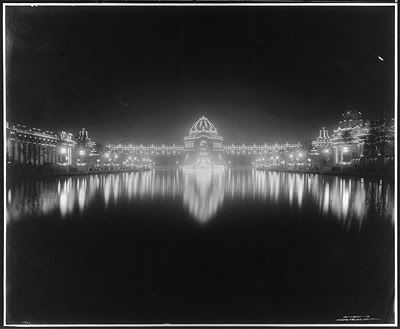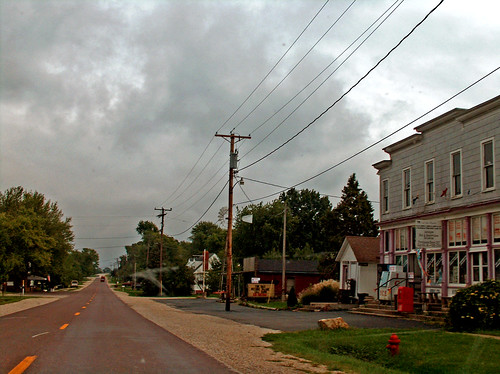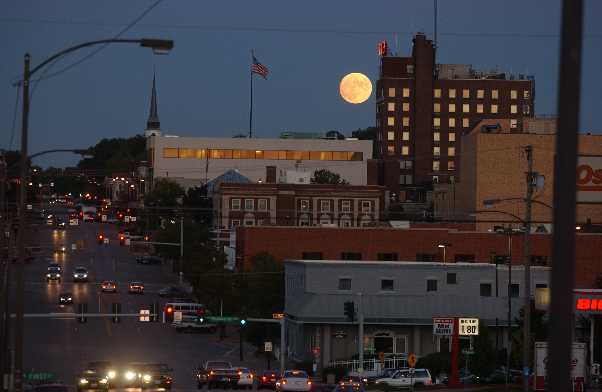Blue Highways: Grayville, Illinois
Click on Thumbnail for MapUnfolding the Map
William Least-Heat Moon stays a night in Grayville, and makes an impression on a farmer in Well's Restaurant at morning breakfast. Click on the map to locate Grayville, and don't be fooled by the map. The horseshoe in the river doesn't exist anymore - you can see the actual course of the river in the satellite view.
Book Quote
"[The man] adjusted his cap. 'So what's your line?'
"'Don't have one.'
"'How's that work?'
"'It doesn't and isn't.'
"He grunted and went back to his coffee. The man took me for a bindlestiff. Next time I'd say I sold ventilated aluminum awnings or repaired long-rinse cycles on Whirlpools. Now my presence disturbed him. After the third tilt of his empty cup, he tried to make sense of me by asking where I was from and why I was so far from home. I hadn't traveled even three hundred miles yet. I told him I planned to drive around the country on the smallest roads I could find.
"'Goddamn,' he said, 'if screwball things don't happen every day even in this town. The country's all alike now.' On that second day of the new season, I guess I was his screwball thing."
Blue Highways: Part 1, Chapter 5
Hard Times Fish Market in Grayville, Illinois
Grayville, Illinois
Have you ever been looked at as odd by someone, or by a group? You might be doing something, standing out from the crowd in some way, and you're seen as being different, and different not in an interesting way but in a way that is slightly disturbing?
It's kind of interesting how, when we challenge someone's notion of what is normal versus what they think of as abnormal behavior, that we get that reaction.
Clearly Least-Heat Moon's (LHM) venture around the country on small roads qualifies as being weird, perhaps abnormal, to this farmer he encounters. Because we don't have much of a backstory on this farmer, it is hard to say what his life was like and whether he did anything that went against the grain in Grayville. Probably not. He probably was born and raised to be a farmer. Perhaps he had his exciting and different moment when he served in the military. Perhaps that was in World War II or the Korean War, or, if he is young enough, maybe even in Vietnam. But that was not something that was out of the ordinary, it was expected of a young man of the time. If he hadn't had that experience, he might have never left Grayville except for the odd trip to St. Louis, which would have made him feel out of place and uncomfortable and therefore he only went once or twice and never went again.
I've not been really wild and crazy, but I have done some things that have been seen as going against the grain, or different. Right out of college, I joined a volunteer program called JVC. It was under the auspices of the Jesuits, a Catholic order of priests and brothers, and I left California and went to Milwaukee where I lived with three women and another man in what we called a "community." We all worked, for what amounted to $75 a month personal spending money, in social service organizations. I lived in the middle of the inner-city, taught at a school in one of the most dangerous neighborhoods, and suffered through property crime in our house and watched a couple of my housemates get beaten on the street. As I related these stories to my family and friends, their reactions typically were "and you're doing this because...?" I was doing it at first because after college, I didn't feel like I had any other options (English majors are great until you need to find a job). I later did it because I felt like I was doing something socially worthwhile that would help those who were poor. I finally learned that the end result gave me more than the people I supposedly were helping, but who had more street smarts and common sense than I did. The kids I taught had grown up before their time, and they were streetwise and in many ways smarter than me. The end result was I rejoined for another year, and lived for eight years beyond my volunteer experience in the inner-city and continued to work in service positions. My extended family shook their heads at times, but I came to love it and found a group of like-minded people that I could count on and who could count on me.
In 1998, I went to Bangladesh, where a different manifestation of being different and odd enough to attract attention happened to me. In a month-long visit, I learned that being whiter and taller than everyone else made me an object of curiousity. My clothes were different. I spoke a different language. I traveled in areas where the appearance of people like me might come once in a generation. In the town of Rajshahi, a crowd followed me as I looked in store windows, watching me window shop. Everywhere in Bangladesh that I stopped in a restaurant outside of the capital of Dhaka, crowds would gather to watch me and my Anglo companion eat. When we stopped to take in the sight of the Bangabandhu Bridge across the Jamuna River, the 5th longest bridge in South Asia, people stood near us to watch us look at the bridge. It was strange, to say the least, to be such an alien object that just my very presence made me worth watching. I didn't have to do anything but just stand there, and I was an attraction. It was both an ego-boost and an unnerving experience.
I think LHM describes a bit of both in this passage. He is an object of curiousity to the farmer, who recognizes that he is not local, and a bit odd because of what he is planning to do. LHM finds it unnerving enough to think about saying something that will make him seem more "normal" in the future, as he doesn't want to be a "screwball thing." But sometimes, we just don't have that option. I had a choice to go back to whatever a normal life is when I lived in Milwaukee, but in Bangladesh, there was no way I would ever be normal in that society. We do what what we can with what we have, and live with whatever people think of us otherwise.
If you want to know more about Grayville
City of Grayville
Topix.com/Grayville
Wikipedia: Grayville
Next up: Tell City, Indiana




 Wednesday, May 26, 2010 at 10:05AM
Wednesday, May 26, 2010 at 10:05AM



